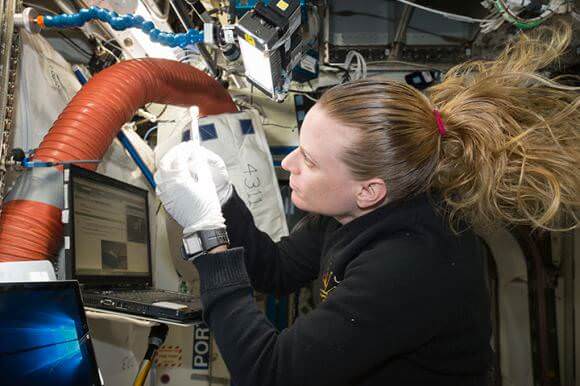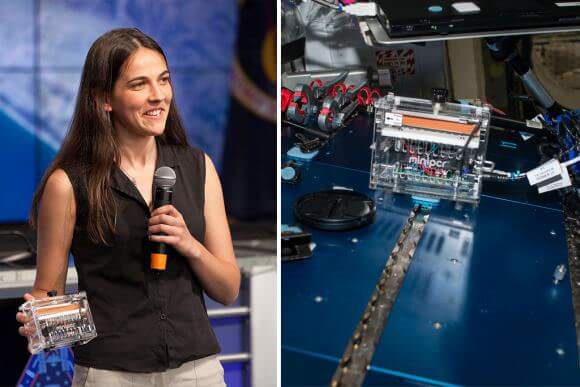Seeking to understand more about space-born microbes, NASA has initiated a program known as Genes in Space-3 - a collaborative effort that will prepare, sequence and identify unknown organisms, entirely from space. For those who might be thinking that this sounds a lot like the film Life - where astronauts revive an alien organism on the International Space Station and everyone dies! - rest assured, this is not the setup for some horror movie.
In truth, it represents a game-changing development that builds on recent accomplishments, where DNA was first synthesized by NASA astronaut Kate Rubin aboard the International Space Station in 2016. Looking ahead, the Genes in Space-3 program will allow astronauts aboard the ISS to collect samples of microbes and study them in-house, rather than having to send them back to Earth for analysis.
The previous experiments performed by Rubin - which were part of the Biomolecule Sequencer investigation - sought to demonstrate that DNA sequencing is feasible in an orbiting spacecraft. The Genes in Space-3 seeks to build on that by establishing a DNA sample-preparation process that would allow ISS crews to identify microbes, monitor crew health, and assist in the search for DNA-based life elsewhere in the Solar System.

NASA astronaut Kate Rubins became the first person to sequence DNA in space and sequenced more than a billion bases during her time aboard the ISS. Credits: NASA
As Sarah Wallace - a NASA microbiologist and the project's Principal Investigator (PI) at the Johnson Space Center - said in a recent press release:
"We have had contamination in parts of the station where fungi was seen growing or biomaterial has been pulled out of a clogged waterline, but we have no idea what it is until the sample gets back down to the lab. On the ISS, we can regularly resupply disinfectants, but as we move beyond low-Earth orbit where the ability for resupply is less frequent, knowing what to disinfect or not becomes very important."
Developed in partnership by NASA's Johnson Space Center and Boeing (and sponsored by the ISS National Lab), this project brings together two previously spaceflight-tested molecular biology tools. First, there is miniPCR, a device which copies targeted pieces of DNA in a process known as Polymerase Chain Reaction (PCR) to create thousands of copies.
This device was developed as part of the student-designed Genes in Space competition, and was successfully tested aboard the ISS during the Genes in Space-1 experiment. Running from September to March of 2016, this experiment sought to test if the alterations to DNA and the weakening of the immune system (both of which happen during spaceflight) are in fact linked.

Student Anna-Sophia Boguraev, winner of the Genes in Space competition, is pictured with the miniPCR device. Credits: NASA
This test will be followed-up this summer with Genes in Space-2 experiment. Running from April to September, this experiment will measure how spaceflight affects telomeres - the protective caps on our chromosomes that are associated with cardiovascular disease and cancers.
The MinION, meanwhile, is a handheld device developed by Oxford Nanopore Technologies. Capable of analyzing DNA and RNA sequences, this technology allows for rapid analysis that is also portable and scalable. It has already been used here on Earth, and was successfully tested aboard the ISS as part of the Biomolecule Sequencer investigation earlier this year.
Combined with some additional enzymes to demonstrate DNA amplification, the Genes in Space-3 experiment will allow astronauts to bring the lab to the microorganisms, rather than the reverse. This will consist of crew members collecting samples from within the space station and then culturing them aboard the orbiting laboratory. The samples will then be prepared for sequencing using the miniPCR and sequenced and identified using the MinION.
As Sarah Stahl, a microbiologist and project scientist, explained, this will allow crews to combat the spread of infectious diseases and bacteria. "The ISS is very clean," she said. "We find a lot of human-associated microorganisms - a lot of common bacteria such as Staphylococcus and Bacillus and different types of familiar fungi like Aspergillus and Penicillium."
In addition to being able to diagnose illnesses and infections in real-time, the experiment will allow for new and exciting research aboard the ISS. This could include identifying DNA-based life on other planets, the samples of which would be returned to the ISS via probe. In addition, if and hen microbes are found floating around in space, they could be returned to the ISS for swift analysis.
Another benefit of the program will come from Earth-based scientists being able to access the experiments going on aboard the ISS in real-time. And scientists here on Earth will also benefit from the tools being employed, which will allow for cheap and effective ways to diagnose viruses, especially in parts of the world where access to a laboratory is not possible.
Once more, the development of systems and tools for use in space - an environment that is not typically conducive to Earth-based technologies - is offering up applications that go far beyond space travel. And in the coming years, ISS-based genetic research could help in the ongoing search for extra-terrestrial life, as well as provide new insights into theories like panspermia (i.e. the cosmos being seeded with life by comets, asteroids and planetoids).
Be sure to enjoy this video titled "Cosmic Carpool", courtesy of NASA's Johnson Space Center:
Further Reading: NASA
No comments:
Post a Comment